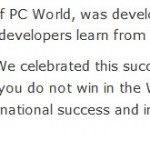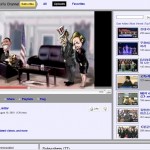UPDATE 2 (11/22/2010): Apparently the boy has not given up on his dream and is now protesting in China (well for one minute). Really. According to the AP:
A 13-year-old American boy campaigning to turn the demilitarized zone between North and South Korea into a peace park tried to get the Chinese president’s attention Monday, staging a brief protest near Tiananmen Square before being led away by police.
Jonathan Lee unfurled a sign saying “peace treaty” and “nuclear free DMZ children’s peace forest” as he stood outside Tiananmen Gate just north of the square in central Beijing.
The scene of numerous demonstrations over the years, the gate and square remain some of the most tightly controlled public spaces in China and all protests on it are quickly snuffed by security agents, sometimes violently. In 1989, tanks and troops rolled into the square to crush a student-led pro-democracy movement, killing at least hundreds of people.
Less than a minute after Lee began his demonstration, a man presumed to be a plainclothes police officer grabbed the boy’s sign and waved away watching journalists, who had been contacted by Lee’s family ahead of time. Three or four uniformed police officers then hurriedly escorted Lee and his mother away without commotion.
Police held the pair and a few hours later Lee and his mother, Melissa Lee, returned to their hotel where they were joined by the boy’s father and sister. The family arrived unaccompanied at Beijing airport Monday evening to catch a Korean Airlines flight to Seoul, but declined to comment to The Associated Press.
The Lees’ treatment by Chinese authorities was relatively mild compared with the often rough handling and swift, forced deportation given to most foreigners who try to stage protests in China. It was not clear if they were forced to leave the country or had already planned to do so.
The boy, from Ridgeland, Mississippi, is trying to persuade the leaders of North and South Korea, China and the United States to work for reunification of the two Koreas.
“Hopefully my picketing will touch them in a way, so they’ll really consider peace, you know, between North and South Korea,” Lee said in an interview Friday with Joel Clark, a documentary filmmaker who traveled to China with the Lees, that was provided to the AP. “I guess I’m just trying to do, you know, what God would want, making peace.”
His Korean-born father, Kyoung Lee, said in a written statement Monday that his son has sent letters to President Barack Obama and South Korean President Lee Myung-Bak but had not been able to give a letter to Chinese President Hu Jintao. That, the father said, made the Tiananmen protest necessary.
Passionate and strong-willed, Lee is the latest, and perhaps youngest, activist to try to bring peace to the heavily militarized Korean peninsula, divided since the 1950-53 Korean War in which both the U.S. and China fought. The U.S. is Seoul’s ally, stationing troops in the well-off nation, while China is the main economic and diplomatic backer of the isolated, impoverished North.
Lee made a rare visit to North Korea in August to propose his idea of a “children’s peace forest” in the demilitarized zone and was taken on a tour of the 2.5-mile (four-kilometer)-wide buffer zone, which is sealed off with electric fences and studded with land mines. A hoped-for meeting with North Korean leader Kim Jong Il did not materialize, although Lee said the officials forwarded to Kim a letter from him.
A U.S. Embassy spokesman declined to comment on the case, saying Lee family members had not signed privacy waivers.
UPDATE 1 (8/19/2010): According ot the AFP:
A US teenager who spent a week in North Korea to promote an idea for a peace forest on the tense Korean border said Thursday his trip had given him “hope” for the future of the peninsula.
Jonathan Lee, a 13-year-old ethnic Korean, said he felt safe and had been treated well during his visit to one of the most secretive states in the world.
Lee said that he headed to Pyongyang with a letter for North Korean leader Kim Jong-Il, proposing the creation of a “children’s peace forest” in the demilitarised zone (DMZ) dividing North and South.
The trip comes amid high cross-border tensions, which grew after South Korea and the United States accused the North in May of torpedoing one of Seoul’s warships with the loss of 46 lives.
“My letter suggesting this (idea) was passed on to Chairman Kim Jong-Il along with my book as a gift to him,” Lee told reporters at Beijing airport, where he stopped for a layover with his parents before flying to Seoul.
“I went to several places but the place that made the biggest impression on me was the DMZ,” said Lee, who hails from the southern US state of Mississippi.
“While at the DMZ, I spoke of my hope of having a children’s peace forest. My suggestion for the motto is ‘Above politics, above conflicts, above borders, above ideology’.”
Lee has sent letters to South Korean President Lee Myung-Bak, US President Barack Obama and China’s President Hu Jintao, explaining his idea for the peace forest of fruit and chestnut trees on the world’s last Cold War frontier.
The surrounding area is heavily fortified with concrete, barbed wire, land mines and soldiers from both North and South Korea.
His visit recalled the efforts of 11-year-old US schoolgirl Samantha Smith, who in 1983 travelled to the Soviet Union at the height of the Cold War, after writing to then leader Yuri Andropov to ask if he planned a nuclear war against the US.
“It’s all about giving hope to the people and children around the world,” said Lee, the founder of a global youth environmental group called I.C.E.Y. H.O.P.E.
“On this trip, I discovered that both sides want reunification, and that Korea is one, so I see hope on the Korean peninsula.”
He told South Korea’s Yonhap news agency that North Korean officials had given a “good” response to his proposal, and that the country’s people were “quite lively”.
The teen also said officials had told his family that progress could be made on his idea only if the United States were to help transform the armistice that ended the 1950-53 Korean War into a full-fledged peace treaty.
North Korea, which has no diplomatic relations with the United States, approved Lee’s trip despite a tense stand-off between the countries over the detention of four American citizens for illegal entry.
Three have been released but but Aijalon Gomes, a 30-year-old former English teacher in Seoul, is still being held in prison there.
Gomes was arrested in January and sentenced to eight years’ hard labour for an illegal border crossing. The North said in July that Gomes had tried to commit suicide and was being treated in hospital.
Lee has previously said his idea was inspired by former South Korean leader Kim Dae-Jung, who died in August last year.
As president from 1998-2003, Kim Dae-Jung held a landmark summit with North Korea’s Kim in 2000 that paved the way for inter-Korean reconciliation and earned him a Nobel peace prize.
ORIGINAL POST (8/11/2010): According to Yonhap:
A teenage American boy says he is traveling to North Korea this week with a letter urging leader Kim Jong-il to allow the creation of a peace forest that would grow over the heavily armed border between the Koreas.
“You may be wondering why a 13-year-old boy wants to go into North Korea, especially right now when there are a lot of problems,” Jonathan Lee, a Korean-American from Mississippi, wrote in his letter.
“Well, I’ve been talking about planting chestnut trees in North Korea for the past three years. The reason I have is because I want to help the environment and help the people at the same time. Now is the right time because many wish for peace right now on the Korean peninsula.”
…
A youth environmental activist who founded in Mississippi the International Cooperation of Environmental Youth – Helping Our Polluted Earth, Jonathan was first moved to pursue the idea of planting chestnut trees on the Korean Peninsula when he met with former South Korean President Kim Dae-jung three years ago.
“His wish for peace between the two Koreas made an impression on me,” he wrote in his letter, recounting the meeting at a celebration of the anniversary of the two Koreas’ 2000 summit.
“Korea has been divided for 60 years and has been officially at war during this time. The children of these countries have never met or interacted with each other. Personally, I think this is sad,” he said.
Jonathan was scheduled to leave Seoul for China on Tuesday, where he will deliver the same letter to Chinese President Hu Jintao. He has already sent the proposal to South Korean President Lee Myung-bak and U.S. President Barack Obama.
Jonathan’s eight-day trip to the communist nation will start Thursday and will include a meeting with a North Korean government official, his father, Kyoung Lee, says. He declined to elaborate.
…
Kyoung Lee believes that safety for his son and his family was guaranteed because their visit was made possible through the North’s U.N. representative in New York.
The family says that they also requested a meeting between Jonathan and the 68-year-old North Korean leader, Kim Jong-il. But the North has only mentioned the possibility of a meeting with a “senior” official.
If Jonathan’s wish to plant a forest of chestnut trees in Panmunjom, along the border between the two Koreas, did come true, it would be a stark contrast to the surrounding area heavily fortified with barbed wire and military personnel, he believes.
Panmunjom, the village where the truce that ended the 1950-53 Korean War was signed, lies within the Demilitarized Zone, a four-kilometer-wide swath of land bisecting the peninsula.
Jonathan says his chestnut trees would “not only help the environment, but would also provide food for the North Koreans.” The North has been suffering from decades of food shortages and deforestation — a consequence of people cutting down trees to plant crops for their survival.
“Above politics; Above conflicts; Above borders; Above ideology; It’s all about giving hope to people and children around the world,” Jonanthan says, referring to his motto for the forest.
“This is the most important part of the letter that Jonathan would like to emphasize,” his father said.
Jonathan’s group, also known as I.C.E.Y.-H.O.P.E., raised funds in South Korea last year and delivered them to the North for use in planting chestnut trees.
Read the full story here:
Teenage U.S. environmentalist to visit N. Korea on bold peace mission
Yonhap
Lee Haye-ah
8/10/2010



